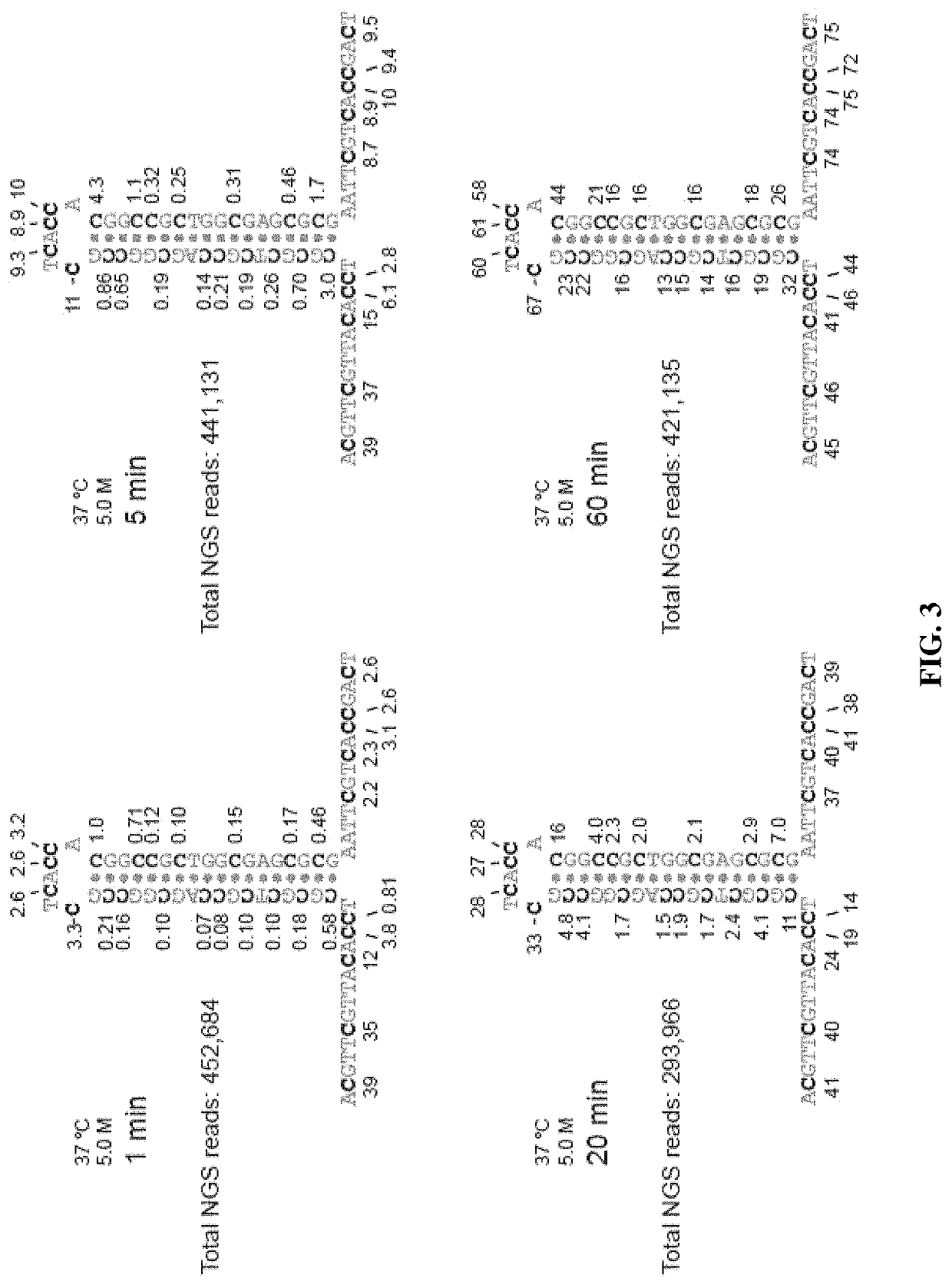Methods for studying nucleotide accessibility in DNA and RNA based on low-yield bisulfite conversion and next-generation sequencing
a technology of dna and rna, which is applied in the field of molecular biology, can solve the problems of low throughput and the inability of xrc to meet the current demand for high-throughput analysis of many different dna and rna molecules
- Summary
- Abstract
- Description
- Claims
- Application Information
AI Technical Summary
Benefits of technology
Problems solved by technology
Method used
Image
Examples
example 1
Validation Via Low-Yield Bisulfite Conversion
[0080]To independently experimentally validate whether the predicted structures based on TEEM parameters are more accurate than the standard parameters, a new method for chemically probing DNA structure was developed. Bisulfite conversion is a chemical process in which unmethylated cytosine (C) nucleotides are converted into uracil (U) nucleotides, and has been typically used for studying epigenetic modification. Literature reports have suggested that strong secondary structures can adversely affect the efficiency of bisulfite conversion, so it was hypothesized that even weak secondary structures could potentially be distinguished via different bisulfite conversion efficiencies, if the reaction time and conditions were modified to reduce overall conversion yield. Use of next-generation sequencing (NGS) to analyze the converted DNA oligos allows highly precise quantitation of conversion efficiencies at single-molecule and single-nucleotide...
example 2
uences and Concentrations Used
[0091]Table 2 lists the sequences of the DNA oligonucleotides used for demonstration of low-yield bisulfite conversion. R nucleotides indicate that the oligo was synthesized as a degenerate randomer sequence with roughly equal probability of each nucleotide being A or G at the R position.
TABLE 2Sequences of DNA oligonucleotidesNameSequenceConc.Hairpin oligoPhosphate-6.7 nM(Oligo 1)CGCCTGGATGCCACAGCCAGCCGTGAGCATAGCCCGCGCTAGTCAGTCATGGTGACCGTCACGTGGCTGCGCGTGGTTGCCATGTGGCCTTTGGGTGGCT (SEQ ID NO: 1)Oligo 2Phosphate-6.7 nMGGCCGAGGGTGGCACGCACAGCACACCTCTCCAGCTAGTGTCAGAGGCCACCTTCCCTTTTATGACCTCCTGGGCTCCTTTGGGACTGACTGGCACCTCT (SEQ ID NO: 2)5-AdapterACACTCTTTCCCTACACGACGCTCTTCCGATCT 40 nM(SEQ ID NO: 3)3-AdapterPhosphate-AGATCGGAAGAGCACACGTCTGAACTCCAGTC- 40 nMC3spacer (SEQ ID NO: 4)5-SplintARRTRTAACRAACRTAGATCGGAAGAGCGT (SEQ ID NO: 5)120 nMOligo15-SplintRTRCCACCCTCRRCCAGATCGGAAGAGCGT (SEQ ID NO: 6)102 nMOligo23-SplintGTGCTCTTCCGATCTARTCRRTRACRAATT (SEQ ID NO: 7) 60 ...
example 3
ration Sequencing (NGS) Data Summary
[0092]Tables 3-4 summarize the number of reads that are C vs. T at each position for each oligo tested. The position of the nucleotide indicates where the C is in the hairpin oligo, counting from the 5′-end. C indicates that bisulfite conversion did not occur, and T indicates that bisulfite conversion did occur.
TABLE 3NGS on hairpin oligo (Oligo 4)*Position of nucleotide261113141618C462,288482,716478,274510,533533,688675,282748,601T310,770290,342294,784262,525239,37097,77624,457Position of nucleotide20222425283132C758,972762,819761,009764,000762,477742,296736,272T14,08610,23912,0499,05810,58130,76236,786Position of nucleotide34363839414445C477,699520,677534,556519,445641,325750,402758,908T295,359252,381238,502253,613131,73322,65614,150Position of nucleotide47515557636668C762,155761,999757,764732,983446,582443,708443,706T10,90311,05915,29440,075326,476329,350329,352Position of nucleotide6972C447,470416,863T325,588356,195*5 min bisulfite conversion,...
PUM
| Property | Measurement | Unit |
|---|---|---|
| Temperature | aaaaa | aaaaa |
| Temperature | aaaaa | aaaaa |
| Temperature | aaaaa | aaaaa |
Abstract
Description
Claims
Application Information
 Login to View More
Login to View More - R&D
- Intellectual Property
- Life Sciences
- Materials
- Tech Scout
- Unparalleled Data Quality
- Higher Quality Content
- 60% Fewer Hallucinations
Browse by: Latest US Patents, China's latest patents, Technical Efficacy Thesaurus, Application Domain, Technology Topic, Popular Technical Reports.
© 2025 PatSnap. All rights reserved.Legal|Privacy policy|Modern Slavery Act Transparency Statement|Sitemap|About US| Contact US: help@patsnap.com



